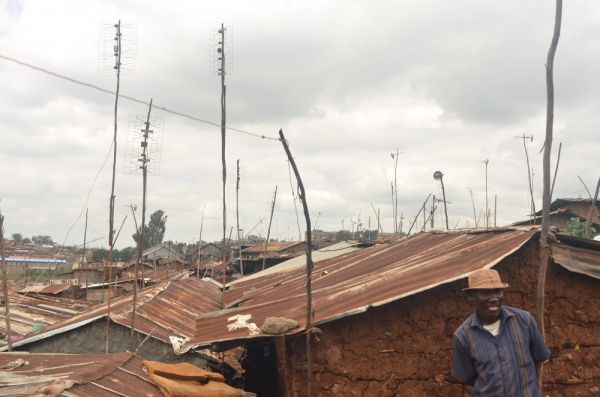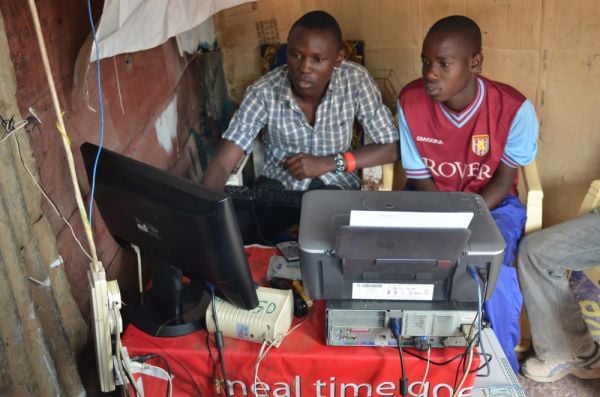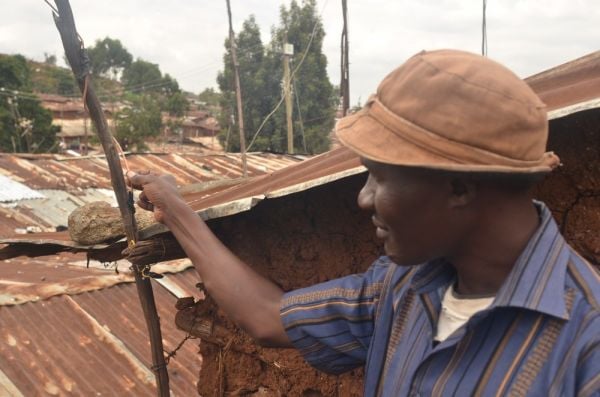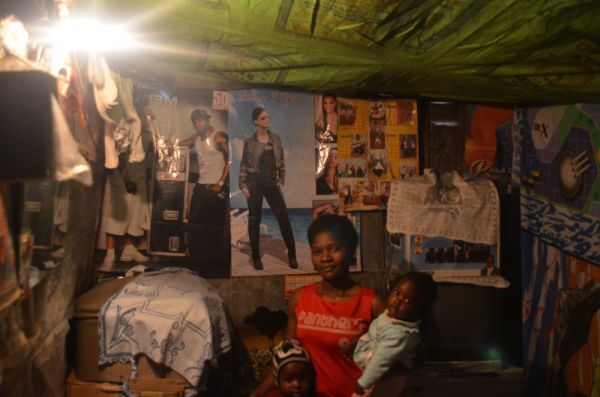The Illegal, Dangerous, Unreliable Electrical System That Everyone Supports

Kibera’s skyline is spiked with the infrastructure of its many illegal electrical hookups.
It’s been a rough month for Kenya Power and Lighting Company (KPLC), Kenya’s sole distributor of electricity. Constant power outages during the rainy season brought thousands of customer complaints. An attempt by KPLC to raise fees was blocked by Kenya’s deputy president, and a Kenyan parliamentarian, citing KPLC underperformance, motioned to break up the company’s monopoly. If that wasn’t enough, a blackout last week plunged most of the country into darkness, shutting down much of East Africa’s biggest economy.
But in Kibera, Kenya’s largest slum, the blackout and weeks of outages were business as usual. “For us it was just normal,” said Steven Opondo, who works at a small download and photocopy shop there. Opondo, 21, said it’s a rare day in Kibera when the electricity stays on. That’s in part because Kibera is severely underserved. The slum is connected to only five transformers, one for every 20,000 or so people. Compare that to the greater Nairobi area, where the ratio is closer to one transformer per 1,000 people.

Steven Opondo in his shop, which is supplied with illegal electricity.
Even so, Opondo is better connected than most in Kenya, where electricity reaches only 25 percent of the population. But his tenuous supply is thanks not to formal infrastructure, but to an illegal architecture of live wires delicately strung above his tin shack. Across Nairobi’s slums, these wires—often repurposed telephone wires—balance on wood and metal poles protruding from rooftops to bring power to the masses. Most wires are rigged by cartels that steal electricity directly from KPLC’s transformers, others set up by people who legally buy electricity and then share, for a fee, with their neighbors. They are far below safety standards, so electrical fires are not uncommon, but many can’t afford anything else.
One electricity reseller is Simon Otieno, who once worked as a KPLC electrician. From Otieno’s Kibera home, a collection of colorful wires snake along the rooftop to his neighbors’ houses. He has thirty clients, and they don’t hesitate to call when connections break down, which he said happens every day. “My lines have circuit breakers so if someone somewhere has a wrong connection the whole system goes off,” he said. “Then I disconnect the wires and follow them one by one until I find the problem.”
For his dedication, Otieno, who didn’t use his real name, charges each client a flat rate of 300 shillings ($3.50 USD) as he’s unable to measure individual usage. Otieno estimated he spends 4,000 shillings per month on electricity, meaning he should earn a profit of 5,000 shillings, nearly $60 USD, each month. But KPLC’s variable service means things rarely work out that way. “Last month there was no electricity in Kibera,” he said, and his costumers refused to pay.

Simon Otieno checks an electrical hookup, which is spliced to send power from his legal connection to one of his customers’ homes.
Still, Otieno has a good reputation. In his three years of business, none of his clients have had a fire, a constant worry when paper- and wood-walled homes are lined with exposed wires. No such luck for Maureen Akinyo, a 21-year-old hairdresser with two young children who buys electricity from a cartel and lost her house to an electrical fire last year.
“I was just outside doing some other things,” Akinyo remembered. “My child he called me, ‘Mommy, look in the house!’” Akinyo rushed to the door, but it was too late. No one was injured, but she saved only a couch cushion.
Akinyo’s house was wired by a friend to power a single bulb, TV and small subwoofer. Akinyo suspects the fire was caused by a surge—the electricity had gone out, which she said happens two or three times a day, but she left the switches on. When the power came back the naked wires overloaded and sparked. After rebuilding, she and her husband hired a different electrician to wire the new house, and are always sure to switch everything off when power goes out. But they still buy electricity from the same cartel.

Maureen Akinyo and her two children in their new home after her other one was destroyed by a fire.
It’s not just customers who accept this system. Otieno said KPLC’s maintenance employees have no problem with his side business. “The Kenya Power people understand that the people here are poor [and need electricity],” he said. “They don’t care about me supplying others.”
Indeed, Benson Muriithi, KPLC’s chief manager of distribution, said his company would like to work with resellers like Otieno. He said KPLC has even approached the cartels, who supply the majority of power to slums, as potential partners, since removing their illegal wires would be ineffective and expensive. According to him, the amount of energy stolen by slum cartels is negligible, less than one percent of total energy compared to the over 12 percent lost to the power grid’s inherent inefficiencies. “That’s why we’re giving them the solution of giving them formal electricity,” he said. “It’s more sustainable than going with the police and doing a raid.”
For now, though, KPLC’s approach to providing formal electricity remains the same: Getting people connected to the grid the old-fashioned way, albeit with new-fangled, subsidized connections. For instance, for $15 anyone, regardless of land ownership, can connect with a quick-install “ready-board” that’s simply a socket and a free compact fluorescent bulb. They can also prepay for electricity via Kenya’s mobile money transfer system, MPesa, eliminating lengthy end-of-the-month billing processes. The ready-boards can’t sustain larger items or home appliances like refrigerators, but can at least provide lighting and charge a phone.
So far, though, even with the ready-board option there are only 1,500 legal connections in slums nationwide. That’s likely in part because the biggest customer complaint isn’t lack of connections — the cartels take care of that — but the constant outages due to overloaded transformers. For Otieno, the Kibera electrician, that’s the issue that really matters. “Kibera people should be brought more transformers,” he said. “Each and every region should have its own transformer.”
Add it to KPLC’s to-do list.
All photos by Jason Patinkin









